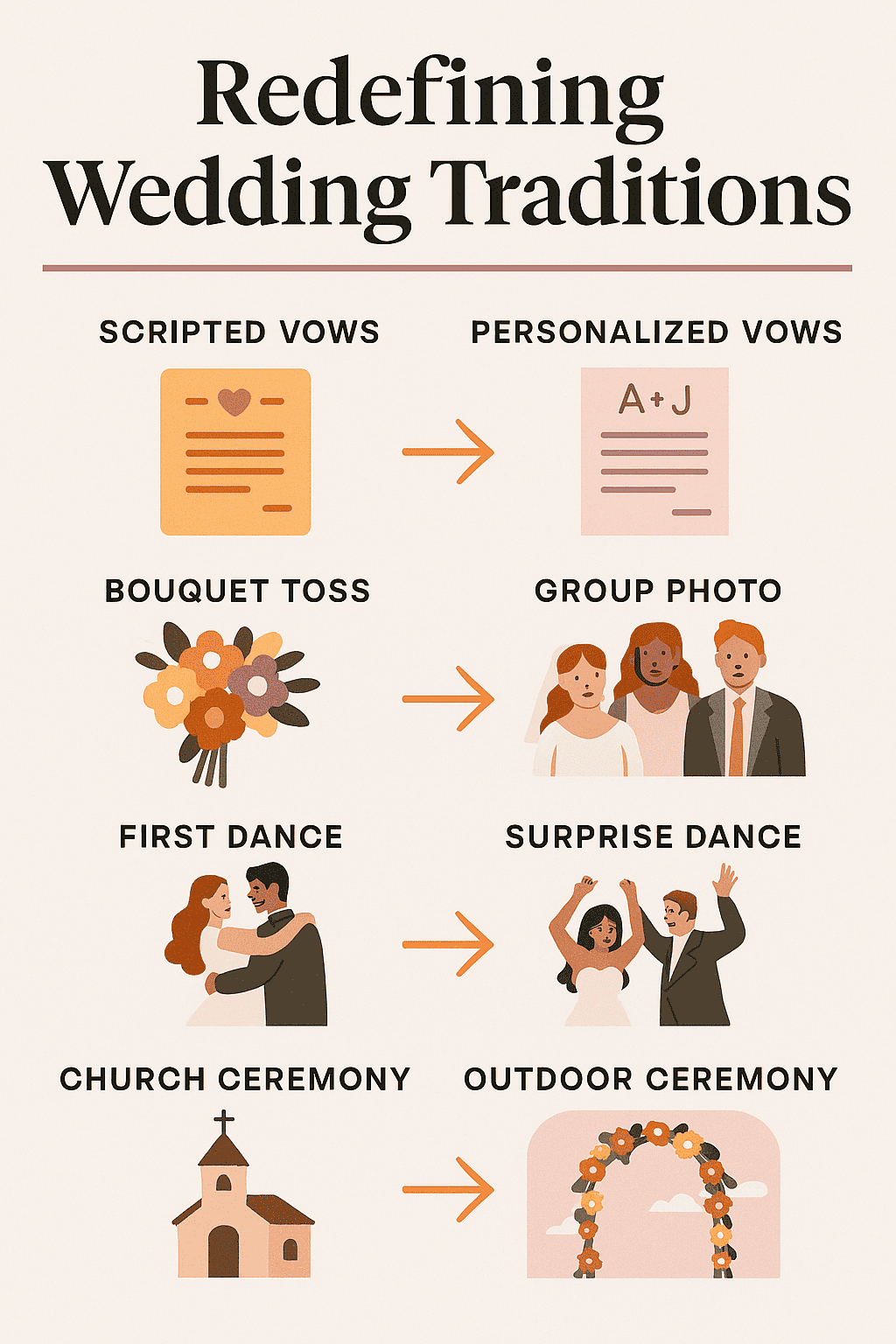The idea of a wedding as a white-dress, aisle-walk, cake-cutting affair is getting a serious makeover. And not just with a fresh coat of Pinterest—this is deeper. In 2025, more couples are tearing up the old script and stitching together ceremonies that feel like them.
This shift isn’t about tossing grandma’s lace veil or ditching the first dance (although those things happen, too). It’s about choice. Intention. Saying, “This matters to us,” and building around that instead of defaulting to what weddings are supposed to be.
In this brave new world of say-yes-to-your-own-dress-code, traditions are being examined like never before. Which ones still hold meaning? Which ones feel performative? And what happens when a couple turns the whole thing on its head and everyone still ends up crying happy tears anyway?
SweetSundayEvents.comThe Classic Ceremony Is No Longer the Blueprint
For decades, the ceremony script barely changed. You walked in, there was some classical music, a reading or two, rings were exchanged, a kiss happened, and off you went to the party. But that blueprint? It’s getting retired—or at least heavily annotated.
Many couples are building their ceremonies from scratch, skipping the “who gives this bride” moment, cutting religious elements, and opting for personalized vows that sound more like love letters than legal language.
Even the seating setup has changed. Who says it has to be in rows? In 2025, we’re seeing circle arrangements, standing-room ceremonies, backyard-style blanket seating, and family members grouped by vibe, not bloodline. It’s giving cozy, communal, and kind of genius.
And officiants? You’re just as likely to hear a sister, best friend, or co-worker officiating as you are a pastor. With sites like American Marriage Ministries offering quick online ordination, anyone can step into that role—usually to great emotional effect.
“We Want the Ceremony to Feel Like Us”
That sentence gets repeated in planner meetings all the time now. Couples aren’t rejecting tradition out of rebellion—they’re customizing out of sincerity.
A 2024 report from Zola showed that over 60% of engaged couples said the ceremony was their top priority for personalization. That includes everything from what’s said at the altar to what music plays, who stands by them, and whether there’s even an aisle at all.
One couple in Austin replaced the standard readings with quotes from their favorite sci-fi novels. Another in Portland had a moment of collective breathwork before the vows. And yet another swapped out flower girls for “beer boys”—yes, groomsmen throwing cans into the crowd before the couple walked in. (Not for everyone, sure, but unforgettable.)
Family Expectations Are Changing (Slowly)
Tradition often has less to do with the couple and more to do with the people watching. But that pressure to please every generation at once is starting to crack. Couples are choosing authenticity over appeasement, and the reactions are surprisingly positive.
Yes, some moms still want the father-daughter dance. Yes, some uncles will grumble about skipping church. But when the ceremony feels deeply personal, most guests get it. They feel it. And in many cases, they remember it more clearly than any cookie-cutter event from years past.
Wedding therapist Allison Moir-Smith notes that couples who prioritize emotional resonance over optics report feeling more grounded throughout their wedding process. That translates to less stress, fewer regrets, and better memories. “When a ceremony reflects who you are,” she says, “it actually brings people closer, even if they don’t totally understand your choices at first.”
Traditions That Are Being Reimagined
SweetSundayEvents.comThe First Look
What used to be considered bad luck—seeing each other before the ceremony—is now an intentional moment of calm. The first look has become a sacred pause before the chaos.
Some couples do it privately, some with their photographers capturing every angle, and others extend it into a pre-ceremony cocktail hour with their whole wedding party. Because who says you can’t sip champagne before saying “I do”?
The Wedding Party
Matching dresses? Gendered sides? Forget it. In 2025, wedding parties are often gender-neutral, dressed to their own comfort levels, and based on closeness, not categories.
One bride had a “man of honor” and her college roommate standing side by side. One groom had his twin sisters as his best people. The point isn’t symmetry—it’s support.
Vows That Sound Like Real People
Some vows now start with “Remember when I clogged your sink?” or “I love you even when you’re wrong about burritos.” Humor and honesty have taken center stage, with couples ditching the stiff language and writing words that feel true to them.
There are online tools like Loverly’s vow guide to help you figure it out, but the best vows come from the gut, not Google.
Venue Choices That Buck Tradition
Courthouses, backyards, bookstores, national parks, record shops—you name it, someone’s gotten married there. Not because it’s trendy (okay, maybe a little), but because it meant something. A couple who met at a jazz club said their vows on that stage.
Two teachers married in their elementary school gym, surrounded by students. A farmer and a florist said “I do” in a field of dahlias. Traditions aren’t gone—they’ve just found new homes.
Reception Rituals Are Getting a Makeover Too
It’s not just the ceremony that’s getting flipped. Receptions are evolving fast. The bouquet toss is fading, often replaced with group shots or dancing circles. Cake cutting isn’t mandatory, especially when dessert tables or late-night snack trucks take its place.
Some couples are introducing a “gratitude moment” instead of a formal toast lineup—thanking their guests at once from the DJ booth, or even passing a microphone around for spontaneous love bombs. (Yes, it’s a thing.)
And instead of the traditional first dance? Think joint karaoke performances, surprise musical numbers, or slow dances to playlists the couple made in high school. What used to feel formulaic now feels like a flex.
It’s Not About Being “Different”—It’s About Being Honest
This trend toward redefining tradition isn’t rooted in a need to stand out—it’s about showing up. These couples aren’t saying no to classic weddings because they’re boring.
They’re saying yes to what feels real. If that means writing your vows in the form of a poem, doing a wine blending ritual instead of unity candles, or walking down the aisle together to a Taylor Swift acoustic cover, then that’s what you do.
It’s also about joy. When couples do things their way, the energy hits different. People cry harder, laugh louder, dance more freely.
Weddings become less about protocol and more about presence. And in a time where everyone’s reevaluating what matters, that shift is huge.
The Numbers Back It Up
According to The Knot’s 2023 Real Weddings Study, 48% of couples said they planned their wedding to reflect their values—up from just 29% five years ago. Zola’s 2024 report found that 59% of couples skipped at least one traditional element entirely, and 22% reimagined their ceremony format altogether.
This isn’t a trend anymore. It’s the new standard.
Traditions That Are Staying Strong (With a Twist)
It’s worth mentioning: some things haven’t vanished—they’ve just adapted. Rings are still exchanged, but maybe they’re tattoos. Dances still happen, but not always first. Speeches still make people sob, but now they might happen over brunch instead of after dinner. Even the white dress endures—because for some, it’s a choice, not a rule.
The point isn’t to burn it all down. It’s to build it back with your fingerprints on it.
Wrapping It Up Without a Bow
Weddings are evolving not because couples are rebellious, but because they’re braver. Braver about being seen. Braver about saying what matters to them. And way braver about ignoring what doesn’t.
Whether you’re getting married under a tree, on a beach, or at your favorite dive bar with a minister who also happens to be your dentist’s cousin—if it feels right, it is.
Tradition doesn’t have to be the villain. But it should never be the boss. Today’s couples are writing new rules—and honestly? They’re better for it.




